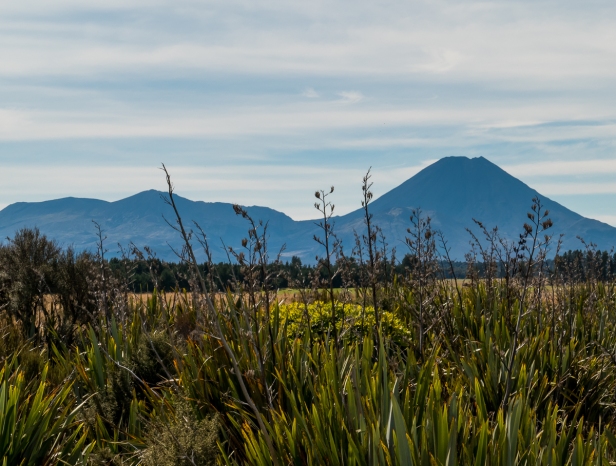
14-17 March 2015. Arriving in the small town of Ohakune, we check into the motel, dump our bags, and go for a short forest hike. Everyone knows about the famed New Zealand silver fern, don’t they? It is New Zealand’s iconic logo. It is the emblem seen on all of the country’s tourism promotions, and on international sports clothing – rugby, cricket, Olympic uniforms: a silver fern frond on a black background. We even bought black underwear decorated with the image of the silver frond for our grandsons. It is the underside of a particular species of fern, and can be used effectively to outline forest tracks in the darkness. We’d seen glimpses of the fern on other forest walks but this time we find a shining example. Finally I understand what it is about.
And at the end of the day, another of New Zealand’s spectacular sunsets.
I had been hoping and hoping Don and I would be fit enough to hike the nineteen kilometres of the famed and much vaunted Tongariro Crossing, which passes by two active volcanoes, Mount Ngauruhoe and Mount Tongariro, with a third, Mount Ruapehu, in the distance. All three are part of the Pacific Ring of Fire. We investigated the idea of hiking just the first couple of stages of the Crossing, but by then you might as well go all the way as turn back. We know we’re not nearly fit enough for that, so we find a hike we can do in the same area. It is enough. It is more than enough. On a magnificent sunny day two chair lifts to take us part way up Mount Ruapehu,
then we continue to the top on foot over the rough gravelly unforgiving volcanic landscape.
We wonder if we’ll ever make it to the top, to the best views. We ask others on their way down if it’s worth it and they assure us it is. Just the next ridge. Then the next. Up and up we go. Then it appears:

From the top we can see the other two volcanoes, and the mountains beyond them stretching out into the distance.
Mount Ngauruhoe, which is the closest to be seen from the top of Mount Ruapehu, is the famed Mount Doom of The Lord of the Rings trilogy of films. What could possibly be a more perfect location for the dreaded evil centre of the story? Even seeing it from a distance I feel the power of the landscape: so barren and merciless. Mordor and Mount Doom are spread out before us.
On a rainy lazy day we drive to the town of Taupo. Lake Taupo, roughly the size of Singapore, is the biggest lake in Australasia. We arrive in time, and in wild weather, for another meeting with the sunset.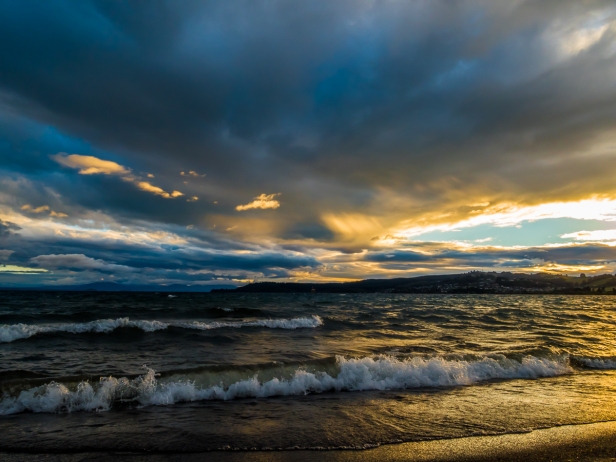
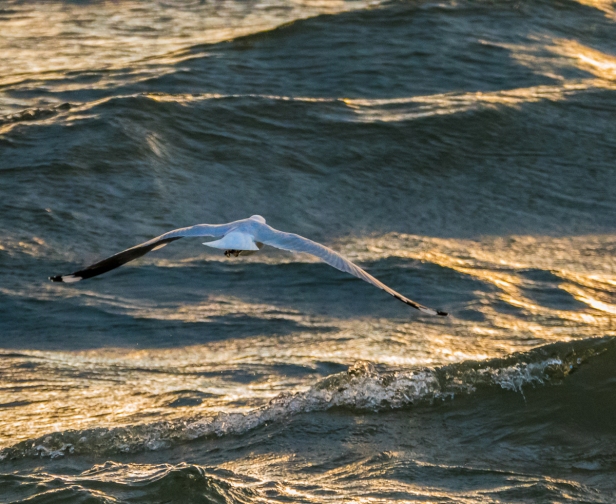
The next morning thankfully the sun has returned for our tour of Hobbiton. If Mordor and Mount Doom are the evil centre of The Lord of the Rings then Hobbiton is the loving heart of it.
From the beginning of the tour we step into a magical world and are completely enchanted. For the next two hours we are shown the entire town, from individual hobbit dwellings, to gardens, to Bag End, to the water mill and the double-arched bridge, and finally the famed Green Dragon Inn. The detail is immaculate, and the feeling of being in a fantastical, but real world, is completely entrancing. It’s easy to believe that people, well hobbits anyway, live here.


Hobbiton is situated on a family livestock farm on New Zealand’s North Island. Originally to be destroyed and the farmland returned to its owners, it was saved due to visitor interest, and then completely rebuilt in 2009 for the filming of The Hobbit. It will remain as a permanent attraction.
Peter Jackson, the director of The Lord of the Rings films first saw the site from the air and felt it looked “like a slice of ancient England”. Jackson wrote: “I knew Hobbiton needed to be warm, comfortable and feel lived in. By letting the weeds grow through the cracks and establishing hedges and little gardens a year before filming, we ended up with an incredibly real place, not just a film set”.
His attention to detail is legendary. The “party tree” that sits above Bag End originally came from the nearby town of Matamata, with leaves being wired on by hand. It was removed after the filming of The Lord of the Rings trilogy as part of the process of returning the land back to the owners. An identical tree, built from steel and silicon, had to be made for the filming of The Hobbit. The leaves were hand painted, and once again were hand-wired onto the tree. Upon seeing it Jackson decided the leaves were the wrong colour. Every single one was re-painted by people up on “cherry pickers”.
Bag End with the “party tree” above.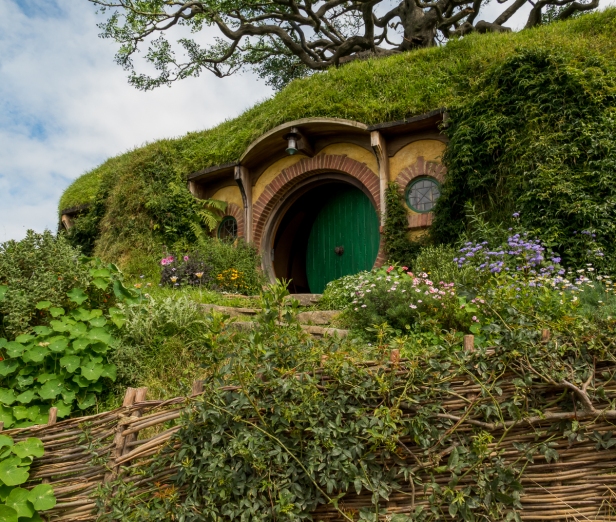
As I walk through the village I become aware of the enterprise of each dwelling. Outside the baker’s house there are loaves of bread for sale, at the beekeeper’s house there is honey for sale.
At the fishmonger’s there is a smoke house and smoked fish for sale.
I notice details like the things in the windows,
the picnic table out front,
the village well,
the lamp down on the dock,
even smoke coming from a chimney,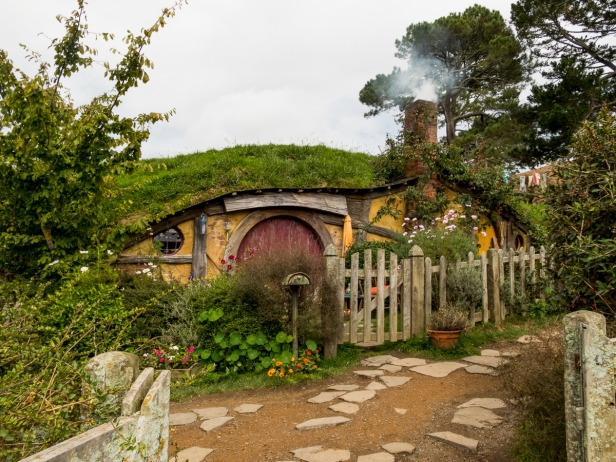
and the clothesline with its old-fashioned pegs. I’ve not seen pegs like that since I was a child at my Gran’s.
Every house is different and yet each retains that quintessential hobbit feeling.


We walk by the mill with its water wheel, cross over the river on the double-arched bridge, and arrive at the Green Dragon Inn, the only human-sized building on the site and the only one with an interior. There are forty-four facades of hobbit houses but no interiors. Interior shots of Bag End were filmed in a studio in Wellington.

Inside the Green Dragon Inn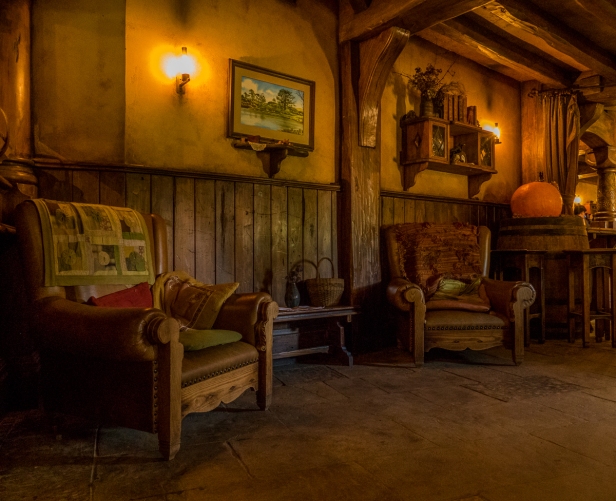

We end the day inhaling yet another glorious sunset, in a seemingly endless procession of glorious sunsets, down by the lake in Taupo.
Next post: the astonishing geothermal fields and geysers of the North Island. A landscape that is simply jaw-dropping.
All words and images by Alison Louise Armstrong unless otherwise noted
© Alison Louise Armstrong and Adventures in Wonderland – a pilgrimage of the heart, 2010-2015.

Bucketlist!!! LOTR fan here…..hobbiton looks awesome😊. Nice shares!!
LikeLiked by 1 person
Thanks so much. Hobbiton definitely amazing. Hope you get to NZ one day – really worth it!
Alison
LikeLiked by 1 person
Utterly brilliant! As usual I’m lost for words to describe such talent and beauty. And yet again, you’ve made my day, Alison and Don.
LikeLiked by 1 person
Thanks so much Ros, I’m so glad you enjoyed it.
Alison
LikeLike
Your landscape shots are quite breath-taking. I do admire you and Don for your intrepid explorations, and the sharing of all your wonderful sights.
LikeLiked by 1 person
Thanks Tish. I’ve been having a lot of fun experimenting with landscape shots lately, and what better place than New Zealand! It’s so beautiful there. I suppose we’re intrepid for a couple of old people lol 🙂
Alison
LikeLike
these are wonderful photos, colorful and different. thanks 😊
LikeLiked by 1 person
Thanks so much Gradmama. Mt Ruapehu and Hobbiton were both wonderful places to visit.
Alison
LikeLike
Thank you for sharing your trip. Hobbiton was amazing. I had no idea of it existed.
LikeLiked by 1 person
You’re welcome Mary, I’m so glad you enjoyed it. Hobbiton is a really special place. I’m so glad we went there.
Alison
LikeLike
Wow! Amazing pictures. You must have loved this visit. So glad they decided to keep Hobbiton.
LikeLiked by 1 person
Thanks Darlene. Yes, we did love this visit, it was really special.
Alison
LikeLike
Strangely, I have not thought much about the Lord of the Rings books since I read them in my youth (I did know there was a film trilogy but did not ever care to see it), but these photos brought back such vivid memories of reading those stories! And the photo of the stormy sunset is mindbogglingly stunning!
LikeLiked by 1 person
Thanks so much lexklein. I had so much fun that evening photographing that sunset. It was cold and windy, but so worth it. And Hobbiton brought back lots of memories for us too – it makes me want to see the movies again. I do recommend them, they’re really good.
Alison
LikeLiked by 1 person
Such beauty! By the end of it all, I’m just speechless.
LikeLiked by 1 person
Thank you so much. Glad you enjoyed it.
Alison xox
LikeLike
I’d forgotten Mt. Doom was also in the neighborhood. Fabulous photos – what an eye you guys have. I am right now in the middle of ‘The Fellowship of the Ring” – and am watching the movies while I read. Such entertainment – including your blog.
LikeLiked by 1 person
Thanks so much Marsha. I really had fun photographing in New Zealand – the landscape is so varied and beautiful. Hobbiton makes me want to see the movies again!
Alison
LikeLiked by 1 person
Thx.
Sent from my iPad
>
LikeLiked by 1 person
You’re welcome!
Alison
LikeLike
Magical!
On the Big Island of Hawaii they have the ethereal Hapuu fern all over the place up in the town of Volcano. Seeing them unfurl in curls, standing taller than I do makes me understand why the silver fern could be so special.
LikeLiked by 1 person
Thanks so much Heather. We found NZ generally to be quite magical, but the sunsets, scenery and Hobbiton all stole our hearts. Soooo much beauty.
I would like to see those ferns in Hawaii – they also sound magical.
Alison
LikeLike
I wish Hobbiton weren’t so far away for so many miles on an airplane. I’d like to see it!
I liked the NZ ferns of all varieties so much that my anklet tattoo’s chain is made of connected NZ fern curls.
Beautiful ocean/sunset shot (the Lake Taupo one): a real wowzer!
LikeLiked by 1 person
Thanks Kate. That sunset photograph – completely bundled in many layers, it was so cold and windy, but worth it for the glorious beauty. Yeah, Hobbiton is definitely worth seeing – quite special. Next time I see you I must take a closer look at your ankle 🙂
Alison
LikeLike
Fabulous photos from start to finish. Hobbiton is fascinating!
LikeLiked by 1 person
Thanks Angeline. Hobbiton is so unique, and yes, fascinating – and magical and enchanting and and a whole lot of fun!
Alison
LikeLiked by 1 person
I just ADORED Hobbiton and you have captured the special feeling and the detail. We spent hours there. On the bus from Matamata the guide asked who has read the books or seen the film and I was embarrassed to be the only person that hadn’t. I corrected that and took out all the videos when I got back home and immersed myself in the Lord of the Rings…
LikeLiked by 1 person
Thanks pommepal, we also spent hours there, and completely adored it. I bet you’re glad that you went anyway even though you weren’t familiar with the story. Going there makes me want to at least see the movies again. Oh and yearn for a time when I could immerse myself in big thick books for hours. Well, it’s just a choice and I have this life now and it’s pretty good 🙂
Alison
LikeLike
I know what you mean about the big thick books Alison. WP has now swallowed up all my book reading time. But I do enjoy reading about other bloggers adventures and doing my posts. I guess life priorities change.
LikeLiked by 1 person
Such magnificent photos of the sunsets and clouds over Lake Taupo. New Zealand is on our someday list but I’m hoping someday gets here soon! Anita
LikeLiked by 1 person
Thanks so much Anita. New Zealand is such a wonderful place to visit. I hope you get there soon. We had 5 weeks there. It is not enough. Allow at least eight! There is so much to see, and in the end we had to make some tough choices and missed the far north and the renowned Bay of Islands.
Alison
LikeLike
Incredible! Hope it is still there when I get to NZ.
LikeLiked by 1 person
Thanks Robyn, yes it is incredible isn’t it?! It will still be there – it’s now a permanent tourist attraction.
Alison
LikeLike
Loved and wallowed in every word of this post, not to mention the pictures.. You made my day, really!
LikeLiked by 1 person
Thank you so much, I’m so glad you enjoyed it. What a wonderful comment!
Alison
LikeLike
So much of interest in your posts, Alison! This is a beauty in every sense of the word. Oh but my knees and hips hurt just looking at that climb, but it just had to be done. Spectacular! 🙂
LikeLiked by 1 person
Thanks s much Jo. New Zealand has so much beauty to offer. Every post I have a hard time choosing photos. Yes, that climb just had to be done – definitely worth it, definitely spectacular, and no problem with hips and knees 🙂
Alison
LikeLiked by 1 person
definitely want to experience New Zealand now. i really love your tour of Hobbiton! fabulous!
LikeLiked by 1 person
Thanks so much Sun. Hobbiton was a real treat, and I definitely recommend NZ. It’s quite amazing.
Alison
LikeLiked by 1 person
Beautiful, amazing, dramatic photos, you have a very special talent for capturing the detail and tell a story with every frame. I love all your posts, but your NZ ones have been outstanding.
LikeLiked by 1 person
Thank you so much Gilda. It’s been a real pleasure putting the NZ posts together, the country is so beautiful and has so much to offer. I still have about 3 or 4 more NZ posts to come – there’s so much to share. I’m glad you’re enjoying them.
Alison
LikeLike
It looks like the hiking effort was worth it. How dramatic! Photos of Hobbiton make me smile. Thanks.
LikeLike
Love this feature, Alison and Don! Your images are beautiful!
LikeLiked by 1 person
Thank you so much Jerriann. NZ is so beautiful, everywhere we went, and there’s so much to see there.
Alison
LikeLiked by 1 person
This is so cool! It kinda amazes me that they were going to tear down the set the first time, but I’m glad it was saved! I’m thinking of going to Australia and New Zealand next June – November, so Hobittown is definitely going on my bucket list!
LikeLiked by 1 person
Thanks Felicity. It’s standard procedure with movies that any location is returned in the same state it was originally found. I think it was just sweet serendipity that so many people went looking for it to see it, and then Jackson getting the green light for The Hobbit movies, that saved it. Now it’s permanent. Like all movie sets it was originally built with perishable materials (non treated wood, styrofoam, etc) but after the owners of the property became aware of the value of keeping it, it was rebuilt for The Hobbit movies with permanent materials. Definitely worth seeing. If you’re going to Oz you must see the Great Barrier Reef, Uluru/Kata Tjuta and Kakadu/Katherine Gorge. The cities are great but get out of them and see the back of beyond. Just a warning both Oz and NZ are expensive. Hostels in both countries are very good – personal experience of NZ and heresay about Oz.
Alison
LikeLike
That breathtaking landscape paired with the magic of Hobbiton makes this one enthralling post Alison! Love every single photo and your eye for detail. Thank you for persevering and treating us to this virtual tour. I am determined to make it there someday.
LikeLiked by 1 person
Thank you so much Madhu. Both climbing that top portion of Ruapehu, and the visit to Hobbiton were fabulous experiences. I’m very much a detail person, and I love miniature, so perhaps that’s why I loved Hobbiton so much. We were completely enchanted. NZ is definitely worth a visit!
Alison
LikeLike
You’re photos really are spectacular. I love the warm feel of the yellow light inside of the Green Dragon Inn, and was reminded of a class I took once on lighting. The instructor was not a fan of such lighting, because it is so weak on the colors of light our eyes need to see and do various tasks. While true, the soft light feels cozy and reminds of times gathered by a fire, sharing stories…
I’m wondering if while in Hobbiton, if you turn and face the other direction, if you see livestock and tractors and other such ranching accoutrements, or if it all blends in pretty well. It doesn’t seem out of place at all in the pictures… It is amazing to me what is spent on getting details right for movies, and I suspect some of our most-gifted crafts people and artists work on projects such as this, and not as often on actual “settings” for human life! Is it another crazy paradox of this world!?
Also, were those actual fish in that picture? They looked like big bats to me, inside of that smoker… Ha!
Glad you both enjoyed the hike and a few chair lift rides…
Thank you for the glimpses of beauty, as always.
Love
Michael
LikeLiked by 1 person
Thanks Michael. I must say I completely disagree with your photography instructor 🙂
The colour in the photos is a good representation of the inside of the Inn, and I’m sure the lighting was designed with exactly the intention you described – soft and cozy and intimate.
Yes, if you face the other direction you see fields of sheep, though I don’t remember much in the way of farming equipment or buildings.
Not actual fish. And not bats lol! Yet another of the many details created by the amazingly skilled and talented craftspeople, and yes sadly this kind of artistic expression is not seen so much in Real Life – Gaudi’s builgings come to mind, and the individual homes of ‘artistic’ friends.
Alison
LikeLiked by 1 person
Well, to this instructor’s defense, it was not a photography course but a course on energy efficient lighting design. You can get away with a lot less lighting, if you have the proper spectrum light, and the proper fixtures… But this is kind of a valid point we’ll make together: efficiency gained at the loss of beauty and presence can never ultimately be the way… 🙂
Not bats… Good…
Michael
LikeLiked by 1 person
Ah, I thought it was a photography course.
A.
LikeLiked by 1 person
I missed this post before! Just got to it somehow, from the new one. Your photos in this set are orgasmic. Love them all again. But truly for some reason, really like the one with the clothes pins (American term for them). Your attention to detail!! Takes us right there. Though I would have liked to see a photo of Don smoking a long pipe sitting in a chair looking out the round door.
LikeLiked by 1 person
Thanks for the comments BF, glad you enjoyed the post. If only there had been real hobbit hole dwellings behind those round doors I would have stayed forever in that enchanting place.
LikeLike
Thanks BF. The landscape from the top of Ruapehu was so striking – powerful and barren all at once. And Hobbiton was just a joy. I’m glad you like the clothesline picture! I almost eliminated that one for not being interesting enough, but a different crop helped, and then I thought that it’s such a sweet example of the kind of detail the place is filled with that I’d include it.
Like Don, I wish we’d been able to see an interior. I remember the interior of Bag End in the movie was really lovely.
Alison
LikeLike
So glad you are enjoying your visit, some great photos and I love your enthusiasm for what you are seeing and doing.
LikeLiked by 1 person
Thanks so much. We loved our visit to NZ. It’s such a beautiful country. Our only ‘problem’ was we didn’t allow enough time. We only had 5 weeks, and could have easily filled up eight. In the end we had to choose between Coromandel and Bay of Islands. But those 5 weeks we had was such a wonderful time.
Alison
LikeLike
Lovely post with beautiful imagery! I was never too sure whether or not I wanted to visit Hobbiton, but seeing all these photos, makes me excited to go! 🙂
LikeLike
Thanks San. Do visit Hobbiton, it’s completely charming. It’s very organised, and you don’t get to wander around alone much, but they don’t rush you.
Alison
LikeLiked by 1 person
Wow!…is all I can say!! Stunning…beautiful…Thank you!! (Oops…I said.more!) 😉
LikeLiked by 1 person
Thank you so much Lorrie. Thank you. I’m glad you enjoyed it. And welcome! It’s lovely to have you here.
Alison
LikeLike
Oh…Thank you Alison 🙂 Your photographs are so beautiful and I just love the life I see in both of you. What an amazing thing to do…just pack up and go!! Who knows…maybe one day I will have the inspiration to do such a thing 🙂
LikeLiked by 1 person
It’s the best thing we ever did!
LikeLiked by 1 person
Dang! Sunsets and moonscape. Awesome pics!
LikeLiked by 1 person
Thanks so much. NZ has awesome scenery just about everywhere you go. We loved it there.
Alison
LikeLike